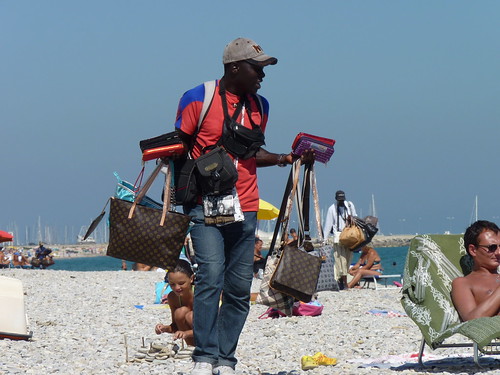A Condominium in Porto Recanati, Italy
South of Porto Recanati, on the Adriatic coast of Italy, is Hotel House, which is not a hotel, it’s a block of flats that is home to 2,000-odd people, nearly all immigrants. No one says much about Hotel House, though it is a sight to behold. Almost a town of its own.
You see it as you drive down the autostrada, and when you pass on the train, a 17-story block of four wings dating from 1970, more than 50 metres high, topped by satellite dishes. This is Hotel House.
The first stone was laid, with Italian ceremony, in 1967. The complex was originally intended as a summer-only hotel, which even for the 1960s seems a bit of an optimistic speculation. It was opened in late 1970. Since the 1980s it has been used to house immigrants.
I am getting the following information from The most dangerous lodger, the Camorra (in Italian) in the online newspaper: Cronache Maceratesi, dated 25 March 2011:
There are 480 apartments, each 70 sq metres. The block houses people from 35 different ethnic origins. Only about 100 of the 2,000-odd are Italian [I’m surprised it’s that many]. The number of inhabitants is said to double during the summer months, when people from north Africa move in to live with their co-nationals, and who sell counterfeit designer-label goods on the beaches of the Adriatic coast, goods that they obtain from the Camorra.
[Now this is odd, for I have never seen a north African selling fake designer goods on the beaches. I have seen plenty of Black African and Asian beach traders, but never a north African. But the local paper should know more than I do possibly.]

African immigrant beach traders, Marina Palmense on the Adriatic coast of Italy. The bags might be counterfeit designer labels, for all I know about it. The source of these bags might be the Camorra. But then again, in either case, they might not. I wouldn’t know. There are three bag sellers in this picture, and this is typical at certain times of the day on Italian beaches in 2011.
Summer apart, the residents of this ‘giant block of cement’ constitute about a sixth of the population of Porto Recanati, though in reality the block is somewhat outside the main town.
The most numerous nationality that lives in the block are Senegalese, followed by Bengalis, Tunisians, Pakistanis, Nigerians, Chinese, Macedonians, Moroccans.
The block houses shops and, (according to the article in Cronache Maceratesi), a swimming pool and is basically self-sufficient – except for income from work of course.
The people in this block live a life that is effectively separate from that of their fellow citizens in the society outside – and this will no doubt suit some very well – though there is an exception with the children, of which there are 400-odd from the apartments who attend school in Porto Recanati.
There are at least sixteen businesses operating at the base of the complex, also a mosque and a pentecostal church. Some of the inhabitants are employed on the security and control of the building [not clear who pays for this].
As might be expected in a conglomeration of people such as this, while the majority are law-abiding and want to live in peace and tranquillity, there are some who are delinquent, and it tends to be these that get Hotel House into the news and that give it its bad name.
In fact as the article in Cronache Maceratesi points out, the repeated criminality and associated violence that some of the residents of Hotel House get involved in can make it seem like Hotel House is like an atomic bomb waiting to explode (the article is a bit colourful in its language).
It’s the Camorra, says the article, that are driving this criminality and violence, partly through bootleg goods but above all it’s the pushing of drugs.
There’s certainly been problems with pushers, and in September 2011 there was talk of the residents forming vigilante groups; some pushers operating in the grounds of the property were beaten up. The carabinieri came in and have attempted to discourage the forming of a citizens police force, they have searched some flats and arrested some illegals and people possessing drugs. But that may be a one-off. The article suggests it’s a regular control since earlier this year, though with the talk of residents’ policing that sounds more Italian hope than planned reality.
And how does the author of the article, Guiseppe Bommarito, know that the Camorra are behind the drug supply? He doesn’t say.
In addition to all its other problems, and as might be imagined, there have been difficulties getting enough water to 3,000 people, some of them 17-floors up, in the middle of nowhere. A piece from the Reformed Communist Party of Italy, Hotel House, You Do Ethnic Cleansing Without Water reports on this in November 2009. Possibly this issue has now been resolved, though equally possibly not.
Hotel House is a ghetto, whichever way you look at it. And as with so many things in Italy, it looks so considerably like a fuse waiting to blow.
Sometimes this can be annoying, but these people really need money. We have to solve somehow this problem...
ReplyDelete